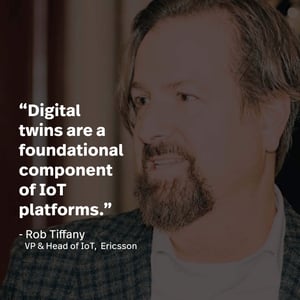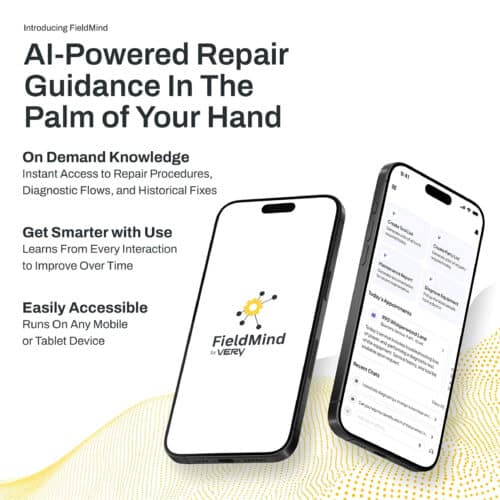BLOG
Learn How Digital Twins Work with Ericsson VP Rob Tiffany
Digital twins sit right at the intersection of IoT, AI, and data analytics, making it possible for modern enterprises to access actionable data and use it to make better decisions. What makes digital twins such a foundational component, and how do they work?

Meet Rob Tiffany
Rob Tiffany is Vice President and Head of IoT Strategy at Ericsson. A bestselling author and frequent keynote speaker, Rob is the Executive Director of the Moab Foundation and is routinely ranked as one of the top IoT experts and influencers in the world.
During Connected Things 2020: WFH Edition, Very partnered with MIT Enterprise Forum Cambridge to bring together industry leaders like Rob Tiffany, VP and Global Head of IoT Strategy at Ericsson, to speak about topics like these. This post includes excerpts from Rob’s presentation, which have been edited for length and clarity. To see and hear the full session, watch the video below.
Where Did Digital Twins Come From?
First things first: what’s the origin of the digital twin? The first example of the digital twin concept being used in the real world, Rob shared, may have been during Apollo 13 – the famous 1970 lunar landing mission that was aborted after an explosion on board.
When things start to go wrong on a spacecraft hovering 200,000 miles above the Earth, what can the team on the ground do? On Apollo 13, they used simulators to calculate the impact of changing conditions on the physical hardware. These primitive digital twins helped mission control to understand what went wrong and guide the astronauts safely home.
Around 30 years later, Dr. Michael Grieves introduced the idea of a “Doubleganger” in the course of his research on product lifecycle management at the University of Michigan. He used the English-German term to describe a virtual replica that is intended to imitate the appearance and behavior of a physical object or system.
While the word itself evolved over the years into the “digital twin” version that we know today, the concept has remained the same and the potential applications continue to grow – particularly in manufacturing. Dr. Grieves recently noted that the digital twin is essential to the success of industry 4.0.
What Are Digital Twin Models and Model Properties?
So, how do you create a digital twin? Rob says that you start by creating a model first, which defines all the properties of the digital twin. If you have experience with object-oriented programming, you might compare this to a base class. The model of a car can provide another great analogy.
If you look at the Model S Tesla, for example, the model establishes all the aspects of the system – from the four tires, which most cars have, to the electric motor that’s more unique to Tesla. What’s especially helpful about the model is that it means you only have to define the properties of a system once, instead of doing it over and over again for each new creation.
Defining Digital Twin Model Properties
Properties help you to define your digital twin model, which will, in turn, make it easier for your IoT platform to label and process incoming data from various events. Rob says it’s like an instruction manual to tell your analytics: here’s what’s coming, and here’s how to work with it. During his presentation, he went over the different kinds of properties your digital twin model might have:
Telemetry and Virtual Properties
Telemetry properties, Rob says, are the most likely to come to mind when you’re thinking about digital twins. Telemetry properties apply to the sensor data coming from your connected machine that tell you something about its state – like the temperature of an engine or RPM.
Virtual properties, meanwhile, are typically calculations of one or more telemetry properties, possibly including some additional reference data as well. The speed of a car, for example, isn’t determined by a single sensor. Instead, it’s a calculated value having to do with how fast the drive shaft is rotating, magnets, and more.
Static properties
Static properties, as the name implies, don’t change very often. In some parts of IoT, especially in the industrial IoT world, people might refer to these as tags when they’re using a programmable logic controller (PLC).
There are two places where you can assign static properties. The first is at the model level. Going back to the car analogy, a static property might be the length of a particular car model.
There can also be static properties or tags at the instance of the twin (the actual car itself). The model of the Tesla S doesn’t tell you what the actual car color is, or the fabric used in the interior, for example, but in the actual car those are properties unlikely to change.
Command properties
Command properties have to do with sending a message to a machine to tell it to do something. The event can be electric, pneumatic, hydraulic, and more. Command properties define how those messages are sent so that the machine “knows” what’s coming.
In the car example, a command property might say, “If a sensor detects the temperature of the engine going above an established safe zone, decrease the RPM until the machine cools off.”
Process properties
Finally, we have process properties. When you’re trying to accomplish a task, it’s not enough just to know the state of all of the machines. You also have to define: what is the task I’m trying to accomplish, and what’s the series of steps I need to take to get there? A digital twin can define those steps with process properties.
The Anatomy of the Digital Twin Instance
Now that we’ve established digital twin models and their properties, it’s time to talk about the actual digital twin instance. Rob says that we need the digital twin to always match what the real, physical entity is doing.

Typically, you’ll bind the digital twin to its physical version through an IoT platform. At this level, IoT security is paramount, so each physical entity will have a unique identifier that matches the digital twin version. There are a variety of ways to authenticate those unique identifiers, like X.509 certificates, but the main goal is to ensure that data is only being passed between trusted sources.
Once you’ve got your digital twin securely set up, you should be able to see almost every aspect of the current state of your physical machine. You can see the historical state over time and use analytics and machine learning to pick up trends and make intelligent decisions.
Additionally, applying rules to digital twins is a relatively simple way to define KPIs and derive value from the streaming data that’s coming in. You can set up basic rules so that data matches colors, for example, where green means good, yellow is a warning sign, and red means bad. After you set up basic rules like these, you can layer on more advanced analytics.
Digital Twin Subsystems and Groups
Digital twin subsystems come into play as the complexity of the machines you’re dealing with increases. A car, for example, isn’t just one thing — it’s a system of systems. You have different systems for the engine, brakes, transmission, fuel, etc.
Some of these subsystems may deserve to have their own digital twins within the larger twin, with a parent-child relationship between them. Each twin has its own properties, and you can begin to tie in causal relationships between what’s happening within one subsystem to how it affects the overall car.
Once you establish those subsystems and relationships, Rob says, you can begin building prescriptive analytics, because the next step once you detect a problem is to determine the best course of action for solving it.
From there, you can start to connect the health of an individual machine to the health of an entire factory — which is where groups come in. Groups bring together machines that interact with each other within a larger setting like a factory.
Think of an assembly line as a group of machines working together to move a product further along in its lifecycle. You’d have a digital twin of the entire line, which would have a parent relationship to the individual machines within the group. Those individual machines would then have parent relationships with their subsystems, which would have parent relationships to individual components, and so on.
An assembly line is truly a great example, Rob says, because an assembly line is a living thing, and if it goes down it can cost businesses hundreds of thousands of dollars for every hour it’s not operating. The line needs to have its own attributes based on what’s happening within its individual components and considering how those elements affect the line as a whole.
Those collections of assembly lines all together make up a giant, living digital twin called a factory — what’s known as a composite digital twin.
Tracing the Digital Thread
Once you’ve set up digital twins for your individual machines and their subsystems, groups, and even your whole factory, Rob says you can start to track what’s called the digital thread. It’s the entire lifecycle of your machine, subsystem, group, and/or factory.
With the digital thread, you can see when failures occurred, when maintenance was performed, and more to create a story of all your assets and systems. From there, you can layer on analytics to understand trends, and even use that data to craft predictive and preventative maintenance solutions.
Conclusion
Digital twins are a key component to bridging the gap between IoT, analytics, and machine learning, particularly in the manufacturing setting. They offer a way to remotely monitor and test connected machines, gather data on their performance, and use the insights to improve productivity and reduce waste.
We enjoyed hearing and sharing Rob’s expert presentation on digital twins since we’re digital twin practitioners ourselves. To learn more about digital twins from an engineer’s perspective, check out our guide here.









